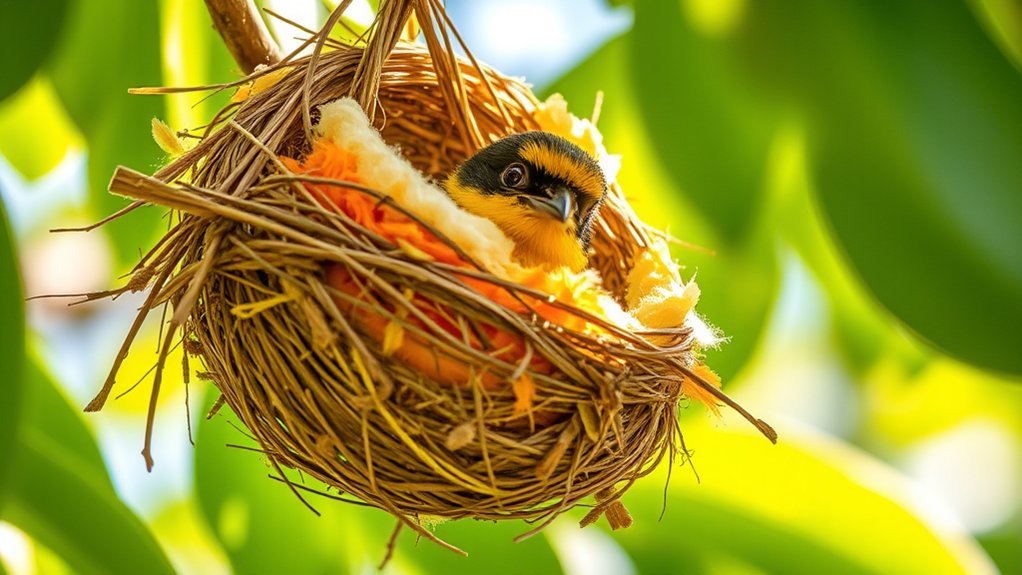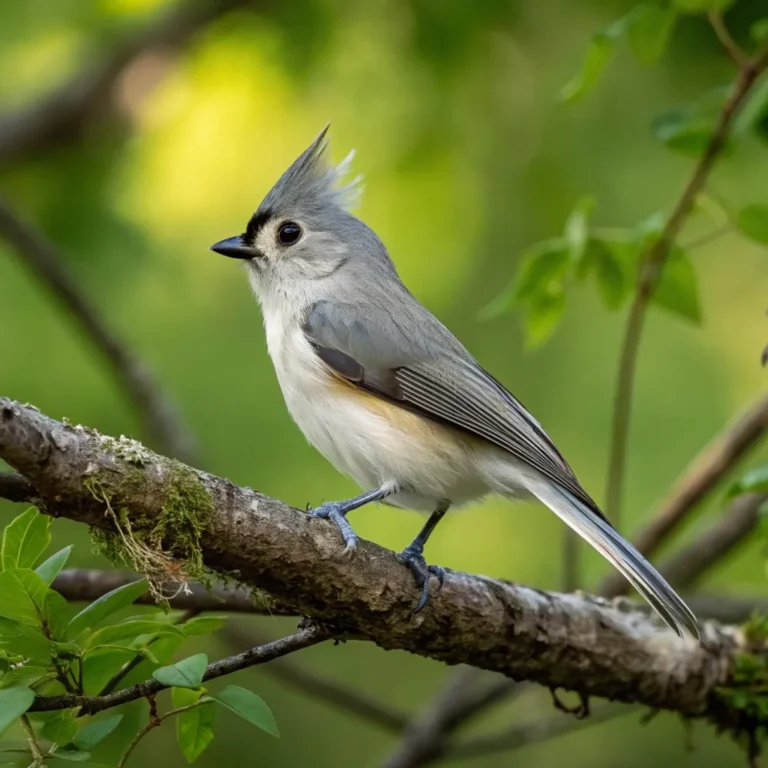Baltimore Orioles Nesting Behaviors: An In-Depth Look at Their Habits
Baltimore Orioles are interesting birds with unique nesting habits. They choose special places to build their nests, showing how smart they are in finding safe spots. They use different materials to make their nests, which helps them survive in their environment.
By looking closely at how they build their nests and keep them safe, we can learn more about how they breed and what problems they face. Changes in the weather and the area they live in can affect their success in raising young birds.
So, next time you see a Baltimore Oriole, think about how they pick their nest locations and what materials they use. It's a great way to appreciate these beautiful birds and their clever ways of living!
A Quick Overview
Baltimore Orioles are known for their special nests. They make hanging nests from grasses, plant fibers, and other things. These nests help keep their young safe from predators.
They pick tall, leafy trees to build their nests. These trees are often near water, which helps the birds find food easily.
When the female lays eggs, she sits on them for 12 to 14 days. During this time, the male looks for food and protects the nest. After the eggs hatch, both parents take care of the baby birds. They feed them and help them grow until the chicks can leave the nest, which takes about 14 to 20 days.
However, changes in the weather, like climate change, can affect how and when they nest. This might cause problems with when they breed and when food is available.
All in all, Baltimore Orioles are hardworking parents that do their best to keep their young safe and healthy!
Overview of Baltimore Oriole Nesting Habits

Baltimore Orioles are known for their unique nesting habits, and these habits help them raise their young successfully. They build nests that hang from tree branches. This design keeps their nests safe from predators, like raccoons and cats, as well as from other birds that might lay eggs in their nests, like Brown-headed Cowbirds.
The female Orioles are the ones doing the building. They use grasses and plant fibers to create strong nests that fit well in their surroundings. This skill shows how they adapt to different places.
Usually, they build their nests in warmer months, taking advantage of the many food sources available. This helps them feed their babies as they grow.
Learning about how Baltimore Orioles build their nests can help you appreciate their strength and cleverness. These birds demonstrate how nature helps different species survive and thrive in their places.
Nest Location Preferences
The Baltimore Orioles build their nests in special places to help their babies grow. They look for spots that keep them safe and are easy to get to. You'll usually find them in leafy trees, especially near water. These places have plenty of food and help protect them from danger.
The Orioles like to build their nests higher up in the trees. Being up high helps them see better and keeps them away from things that might bother them.
Materials Used in Nest Construction

Baltimore Orioles carefully pick materials for their nests. They want to make sure their homes are strong and keep their babies warm.
They use plant fibers like grasses and reeds, and they add strips of bark and animal hair to build a solid base.
These materials help protect the eggs and chicks. Orioles sometimes use plastic, string, or paper in their nests. This shows how flexible they can be!
By choosing these items, they show smart building skills that keep their little ones safe and cozy.
Watching these birds gather materials can make you admire them even more.
Their nest-building habits remind us how important it's to find community and support in nature.
Nest Building Techniques
Baltimore Orioles are amazing builders! When they make nests, they use cool techniques to keep their homes strong and safe. They gather long strands of grass and plant fibers.
Then, they weave these materials together to create well-structured nests that can handle wind and rain.
These crafty birds often hang their nests from tree branches. This helps keep their homes away from hungry predators. They also add bits of mud and other materials to make their nests even sturdier.
Watching these birds build nests shows how smart and adaptable they are. They work hard to make a safe place for their young, ensuring they've a cozy home to grow up in.
Isn't that neat?
Nest Size and Structure

Nest size and structure are really important for Baltimore Orioles. A good nest is usually six to eight inches deep. This size is just right for their eggs and baby birds.
Orioles make their nests with tightly woven grasses, strips of bark, and bits of animal fur. This mix keeps the eggs warm and safe from danger. The nests are built in a way that helps the chicks grow. They also stay out of sight from predators.
Most of the time, orioles hang their nests from tree branches. This way, if something tries to knock them down, gravity helps keep the nests in place.
All these features help the baby birds grow up strong and healthy. This means more Baltimore Orioles can thrive in your area!
Timing of Nesting Season
The nesting season for Baltimore Orioles is very important for their success. When spring comes, these birds return from their long journey. Several key signs tell them it's time to start breeding.
Here are some of the signals that help Baltimore Orioles know nesting time is here:
- Longer days mean warmer weather is on the way.
- There are plenty of bugs to eat in the spring.
- Changes in temperature and new plants show perfect nesting spots.
- Male Baltimore Orioles compete for the best places to build nests as they arrive.
These signs help Baltimore Orioles time their nesting with good weather, giving their baby birds the best chance to grow up healthy.
Watching these birds can help you feel more connected to nature and its cycles.
Mating and Pair Bonding
As spring arrives, Baltimore Orioles return to their homes to find mates. They start colorful dances and sing beautiful songs. Male orioles show off their bright feathers to attract female orioles. These displays help the females choose the healthiest males, which is important for having strong baby birds.
Once a male and female form a pair, they take care of each other. They often clean each other's feathers and protect their territory together. This teamwork makes their bond stronger and helps them prepare for building a nest and raising their young.
Incubation Process
When a pair of Baltimore Orioles fall in love, they start building their nest. This is an important step for their future babies.
After the nest is ready, they begin to incubate their eggs. This means they keep the eggs warm and safe. It usually takes about 12 to 14 days for the eggs to hatch.
- The female Oriole sits on the eggs most of the time.
- The eggs need to be kept at a cozy temperature between 36-38°C (97-100°F).
- The male Oriole helps by bringing food to the female.
- They also make sure their nest is safe from predators who might want to harm the eggs.
Knowing about this process shows you how much the Orioles care for their soon-to-be chicks. It's lovely to see how both parents work together!
Parental Care of Chicks
After the Baltimore Oriole chicks hatch, they need a lot of help from both parents to stay alive and grow strong.
During this time, the mother usually takes charge of feeding the chicks. She brings them tasty insects and fruits, which are very important for their growth. The father helps by protecting the nest and also bringing extra food.
This teamwork makes sure the chicks get enough food and are safe, which helps them grow quickly.
The parents talk to each other and change what they're doing based on what the chicks need. Working together not only helps their young but also brings the parents closer. It shows how important it's for both to share the job of taking care of their chicks.
Nestling Development Stages
The growth of Baltimore Oriole nestlings happens in four main stages. Each stage is important for their survival.
- Hatching: Baby birds come out of their eggs in about 12 to 14 days.
- Feeding: At first, the parents give them high-protein food. This helps the babies grow fast.
- Fledging: In 14 to 20 days, the nestlings start to flap their wings. They get ready to live on their own.
- Independence: After they leave the nest, the young birds depend less on their parents. They begin to find food and survive by themselves.
Watching these stages shows how important feeding is for the nestlings. It also helps us appreciate how strong these little birds are as they grow up.
Predation and Nest Protection Strategies
Baltimore Orioles are beautiful birds with bright colors and sweet songs. However, they've to watch out for predators that could hurt their nests. These birds are very alert and can see danger around them.
To keep safe, Baltimore Orioles build their nests in high places, like tall trees or thick bushes. This makes it hard for ground predators to reach them.
Sometimes, you might hear them making loud alarm calls. This is their way of warning other orioles and different birds about danger nearby. These calls help all the birds stay safe by looking out for each other.
Learning about how Baltimore Orioles protect themselves makes us appreciate their smart choices and strong instincts in nature.
Abandonment and Re-Nesting Behaviors
Baltimore Orioles are careful birds, but sometimes they've to leave their nests. They might abandon their nests because of people getting too close, threats from other animals, or losing a partner.
When this happens, orioles have a few smart ways to start over and protect their young.
First, they look for new spots to build their nests. They often pick different trees or bushes to stay safe from danger.
Next, orioles can reuse parts of their old nests. They take materials from their abandoned nest to help them make a new one. This way, they save time and energy.
Timing is important, too. Orioles can change when they breed based on the weather and the season. If conditions are better at a different time, they'll adjust accordingly.
Finally, they try to find quieter places to build their nests. By choosing a peaceful spot, they can reduce stress and focus on raising their young.
Understanding these behaviors helps us see how strong and smart Baltimore Orioles are. They know how to adapt and face challenges head-on!
Impact of Environmental Changes on Nesting
As the environment changes, we can see its impact on Baltimore Orioles and their nesting habits. Climate change and habitat loss are making it harder for these birds to find safe places to build their nests.
Warmer weather can cause them to breed earlier, but this mightn't match when food is available. If they've chicks but there's not enough food, the young birds mightn't survive.
Also, losing important places like wetlands and forests means fewer options for where they can nest. This forces Baltimore Orioles to seek out less suitable areas, which can be risky for them.
If you want to help these beautiful birds, consider getting involved in efforts to restore their habitats or raise awareness about climate change.
Frequently Asked Questions
Do Baltimore Orioles Reuse Nests From Previous Seasons?
Baltimore Orioles usually don't use old nests. Each year, they build new ones. They take care of their nests, but they like to find new spots each time. This helps them stay safe from predators and keeps their young birds protected. Building in different places each year is a smart choice for them!
How Do Environmental Changes Affect Overall Oriole Populations?
Environmental changes, like shifts in climate and loss of homes, are a big deal for orioles. These changes make it harder for them to find places to nest and enough food to eat. This can put their lives at risk and also changes the balance of nature around them.
When orioles can't find safe spots to build their nests, they might not have babies or their babies might not survive. Less food means they can't stay strong and healthy. This not only affects orioles but can also impact other animals and plants in their area.
It's important to pay attention to how our actions can create these environmental changes. By helping the environment, we can support oriole populations and the whole ecosystem.
Can Baltimore Orioles Be Attracted to Artificial Nesting Sites?
Yes, Baltimore orioles can be attracted to artificial nesting sites! If you want to encourage them, add some suitable nesting materials nearby. They love to build nests with items like yarn, string, or grasses.
It also helps to set up feeders close to these nesting spots. The feeders can draw orioles in for food, making them more likely to check out the nesting area. By providing these options, you can create a friendly spot for orioles to visit and maybe even nest!
What Predators Are Most Common to Baltimore Oriole Nests?
Baltimore Oriole nests face threats from some common predators. Snakes, raccoons, and different types of birds of prey often target their nests.
To help these birds stay safe, it's important for them to have strategies to protect their nests. These strategies can make it easier for them to breed successfully and raise their young.
If you love nature, watching how Orioles build their nests and defend them can be really exciting!
How Do Urban Environments Impact Baltimore Oriole Nesting Behaviors?
Urban areas change how Baltimore Orioles build their nests. In cities, these birds find different food and places to live. They use local plants and buildings to help them nest. This can affect how well they raise their young and how healthy their population is.
Baltimore Orioles are smart and adaptable. They adjust their nesting habits to survive in cities. Instead of only using trees, they may nest in parks or near homes. This helps them find food and shelter. The changes in their environment also mean they need to be more creative when building their nests.

Joyce is the passionate founder of Chirping Hearts, a website dedicated to sharing her love for birds and providing valuable information about avian life. With a background in ornithology and years of experience in birdwatching, Joyce aims to inspire others to appreciate the beauty and diversity of birds. Through her engaging articles and guides, she hopes to foster a community of bird enthusiasts who share her enthusiasm for these incredible creatures. When she’s not writing, Joyce enjoys exploring nature trails and observing birds in their natural habitats.







